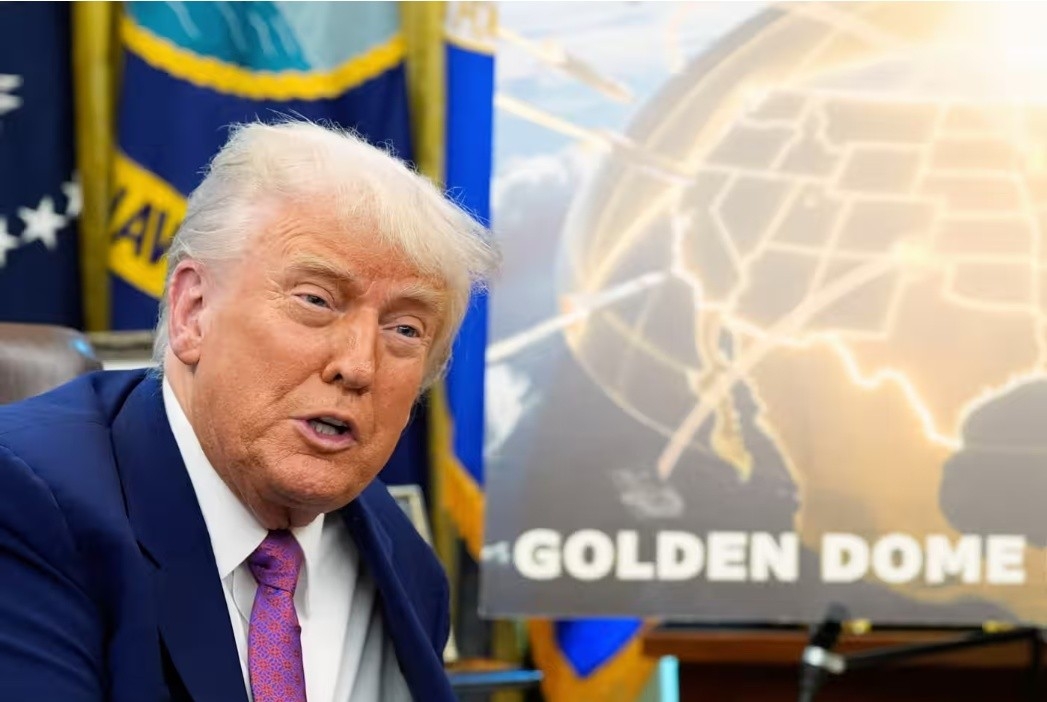It has been described it as strategically meaningless, technically meaningless and economically meaningless. Yet this defense system could lead the world into conflict by destabilizing global strategic forces.

U.S. President Donald Trump speaks in the Oval Office of the White House on 20 May, 2025. Pentagon officials expect a space-based weapon to be ready only for a demonstration by 2028. (Photo: Alex Brandon/AP)
The “Golden Dome” missile defense system being promoted by U.S. President Donald Trump is explicitly directed at “peer” or “near-peer” competitors. This approach threatens to destabilize the current strategic balance between major powers and further exacerbates an already deteriorating global security dilemma.
On May 20, the United States unveiled the final architecture of the system, which expands the scope of U.S. missile defense beyond so-called “rogue states” to include major powers of comparable strength. The plan also includes the deployment of offensive weapons in outer space — a move that could seriously undermine global security, violate the principle of the peaceful use of outer space and further destabilize an already volatile international security environment.
Based on the Trump doctrine of “America first,” the U.S. aims to establish an unrestricted, global, multilayered and multi-domain air and missile defense architecture. The system is designed to achieve absolute security by intercepting hypersonic missiles, ballistic missiles, cruise missiles and even drones launched from Earth or space. It seeks to integrate existing mid-course and terminal missile defense capabilities with emerging technologies, particularly in boost-phase interception.
The U.S. continues to enhance both land- and sea-based missile defense platforms while aggressively developing space-based assets. These include space sensors for tracking hypersonic and ballistic threats, space-based interceptors for boost-phase interception and a low Earth orbit satellite network for global battlefield surveillance and target identification.
But strategic defense is not solely about protection; it also directly affects the balance and stability of global strategic forces and, by extension, world peace. A key lesson from the U.S.-Soviet arms race during the Cold War is that efforts to achieve absolute security through strategic defense systems inevitably provoke countermeasures, resulting in the escalation of offensive weapons development. This realization led to the Anti-Ballistic Missile Treaty, under which both nations agreed to limit missile defense initiatives.
However, after the Cold War, the United States unilaterally withdrew from the ABM Treaty and resumed the development and deployment of missile defense systems — all the while continuing to claim that these systems were not intended to undermine the nuclear deterrents of Russia or China.
Golden Dome marks a significant departure from this posture, as it explicitly targets peer and near-peer competitors. This threatens to disrupt the global strategic balance of power and deepen the already complex international security dilemma.
By openly incorporating space-based offensive capabilities into the Golden Dome system, the United States is contravening the principle of the peaceful use of outer space. The Outer Space Treaty affirms that the exploration and use of outer space should serve peaceful purposes and be in the collective interest of all humankind. It also mandates that states uphold international law and the UN Charter to preserve international peace and security.
While the treaty specifically prohibits the deployment of weapons of mass destruction in space and does not explicitly ban conventional weapons, the global community has long exercised restraint in militarizing space. To date, no nation has openly deployed either kinetic or non-kinetic offensive weapons in orbit. Golden Dome, however, envisions the large-scale deployment of space-based reconnaissance, tracking systems and interceptors — things that would significantly raise the risk of space conflict and war. This path threatens the long-term peaceful development and sustainable use of outer space, with profound consequences for all of humanity.
In addition, Golden Dome’s measures for active launch suppression and boost-phase interception are likely to escalate conflicts. The United States plans to take action before an adversary’s missile is launched — known as “active launch suppression” or “left-of-launch” missile defense. Such preemptive actions can easily exacerbate tensions and lead to larger-scale confrontations.
Boost-phase interception, which takes place shortly after a missile is launched, targets missiles when they are slower and more vulnerable. However, these interceptions typically occur over an adversary’s territory, carrying a high risk of escalation.
The Golden Dome is essentially an updated iteration of the former “Star Wars” program. The original initiative was scaled back and restructured because of exorbitant costs and technical difficulties, and it ultimately failed to achieve its intended goals. Now, with the rapid development of emerging technologies, the U.S. government appears to be reviving the “Star Wars” dream — but the old problems remain unresolved.
Technologically, the American Physical Society has stated, intercepting a single missile would require the deployment of thousands of interceptors in low Earth orbit. To counter just 10 solid-fueled intercontinental ballistic missiles, approximately 16,000 interceptors would be needed. Economically, while the Trump administration estimated the cost of Golden Dome at $175 billion, the Congressional Budget Office projected that it could exceed $500 billion over the next 20 years.
As a result, former Democratic Congressman John Tierney described it as strategically meaningless, technically meaningless and economically meaningless. Yet such a flawed defense system could lead the United States to become blindly overconfident, increasingly reliant on military force and more inclined to resort to nuclear threats — or even nuclear strikes — to resolve disputes. This would significantly increase the risk of international conflict.
Maintaining global strategic stability and the peaceful use of outer space is in the common interest of the international community, as well as in the long-term interest of the United States itself. The U.S. government should abandon these misguided plans and instead build its strategic defense on respect for the core interests of all nations and refrain from interference in other countries’ internal affairs. That would be a better “dome.”
